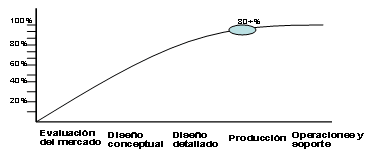Forget the Total Cost of Ownership - Project Lifecycle Management Implies Long Term Value
Product lifecycle management (PLM) software vendors are consistent in their belief that PLM applications software is well worth the investment because the life cycle costs of new product design and initiation (NPDI) are inherently weighted at the front end. Therefore the better job a company does in managing an efficient process toward NPDI will imply considerable cost savings over time. After a product launch, there are additional and significant gains that can be achieved by properly and efficiently managing the product life cycle through product retirement, but the real nugget for most manufacturers lies in the front-end of the product design and development cycle where an average (over multiple long NPDI industries) of over 80 percent of the costs resides.
Life Cycle Costs Over Time—Efficiency Starts with Design
Current global market forces are driving the need for manufacturers to re-examine their ways of conducting business, and are, in turn, driving PLM applications initiatives. These global market forces include
- Mergers and acquisitions
- Outsourcing and off-shoring
- Globally distributed manufacturing operations
- Broader supply chain networks
- New product market opportunities
At the same time, the recognition of inefficiencies and complexities across comprehensive business processes throughout a companies' design, engineering, manufacturing, marketing, and support organization are driving interest in PLM:
- Market assessment including segmentation and demographics
- Forecast demand and market window
- Conceptual design and product definition
- Detailed design
- Manufacturing release and change management
- Parts selection and sourcing
- Production process planning
- Market rollout
- Aftermarket support
- Portfolio management
The dynamics of these global market forces coupled with existing but inefficient product development business processes are opening the door to increasing PLM software adoption. Manufacturers are achieving better time-to-market improvements from the adoption of NPDI techniques and technology, but there are still bottlenecks during execution of these processes. Global design teams are becoming more commonplace due to mergers and acquisitions and outsourcing, dictating a more dispersed cross-functional team to collaborate on NPDI. Global expansion is also seeding collaborative NPDI activities. At the same time, regulatory requirements and other compliance initiatives are increasing the data capture requirements as new products go to market. Studies show that NPDI cycles are shrinking, indicating that collective PLM targeted processes and technology are paying off.
PLM Payback Is Complex and Subjective, But Real
Demand for PLM and recognition of value can be translated by the fact that key vendors like PTC, Dassault Systems, Agile, MatrixOne, and UGS are experiencing mixed to healthy growth in revenues for both design tools and broader PLM capabilities. PLM vendors, as a group, are meeting or exceeding market growth expectations, and the bar has been set high. The CEO of Compaq was recently quoted as saying that PLM offers "more pure ROI" than any other business application. So where does the value come from? Many of the subjective revenue gains and objective cost reductions lie in
- Improved new product design innovation
- Coordination across multiple product design and development locations
- Improved design quality while reducing design cost
- Reduced product time-to-market cycle times
- Better support for customers located worldwide
- Opportunity recognition via portfolio management
- Improved custom product development
- Enabled patent management
- Improved channel management
- Enabled intellectual property management
The Business Case for PLM Varies by Industry and Timeframe
Each industry has its own view of how PLM can improve efficiency, and what drives the business case for initiating PLM projects. Industries with short NPI and short product life cycles, like electronics and apparel, are "manufacturing" driven. Their focus is on the advantages gained through PLM concept adoption from design to mass production product launch. At the other end of the spectrum, industries like automotive, aerospace and defence (A&D), and pharmaceuticals have long product life cycles and long NPI cycles. They are "program" driven, and stand to gain from PLM initiatives focused on collaborative design, project management, portfolio management, and product retirement.
Total Cost of Ownership (TCO) Models is Overkill
Total cost of ownership (TCO) is a holistic way to view the true costs of IT investment throughout an applications' life cycle. TCO is a way to understand and analyze the costs, efficiencies, and economic impacts associated with procuring, using, and maintaining IT application components over time. In short, it is the "cradle to grave" costs associated to IT investments. TCO of a PLM environment is the total cost of procuring, operating, and maintaining PLM applications including hardware, software, training, peripherals, servers and local area networks (LAN) equipment including hidden and indirect costs like training and support throughout the life cycle of the PLM software assets.
Consulting firms that specialize in TCO assessments for software acquisition embrace a TCO philosophy based on the best practices surrounding application life cycle management including acquisition, deployment, service, and support, as well as revision control. TCO benchmarks exist for detailed analysis of current expenditures related to hardware and software, operations, administration, as well as end user operations and downtime. Topics such as staffing information, outsourcing fees, service desk metrics; dispatched support calls can all be included in a thorough TCO analysis.
PLM, as a strategy, is as much process definition as it is technology. Any TCO analysis examining the costs associated with a PLM application must as well examine the scope and level of best practices you have implemented in your company today as well as in the future. This requires a sharp view of both the "as-is" and "to-be" state of a companies' product design and development cycle.
But this type of analysis can be time consuming, laborious, and expensive and is most likely not warranted if one takes a more simplified approach. A considerably more simple yet logical approach for manufacturers initiating a PLM project involves developing a process flow schematic of product design and development processes, determining estimated or average durations by process, and comparing the reduction of product life cycle design and development time versus the over all product design and development costs. A mere percentage of savings in life cycle time can result in big dollar savings. Hacking off a week or two of product development time, and the resulting ripple effect throughout the product life cycle, can result in considerable savings that far exceed the TCO of a PLM application.
Conclusion
There is no need to succumb to analysis paralysis when it comes to justifying a PLM applications investment if you understand the nature and specifics of your product development life cycles. Appraisal of cost savings based on incremental reductions of product design and development times in most cases will far outweigh the TCO of a PLM package. To date, most companies have adopted an incremental approach to implementing PLM and have been directing immediate attention to projects that solve tangible problems with short term paybacks.
Long term, the benefits can be substantial, albeit subjective, in terms of measurement. Senior management needs to trust in instinct and common sense at times when forces are colliding to warrant prudent but immediate investment in PLM.
Call us to find out how inScope PM's can help your organization.

